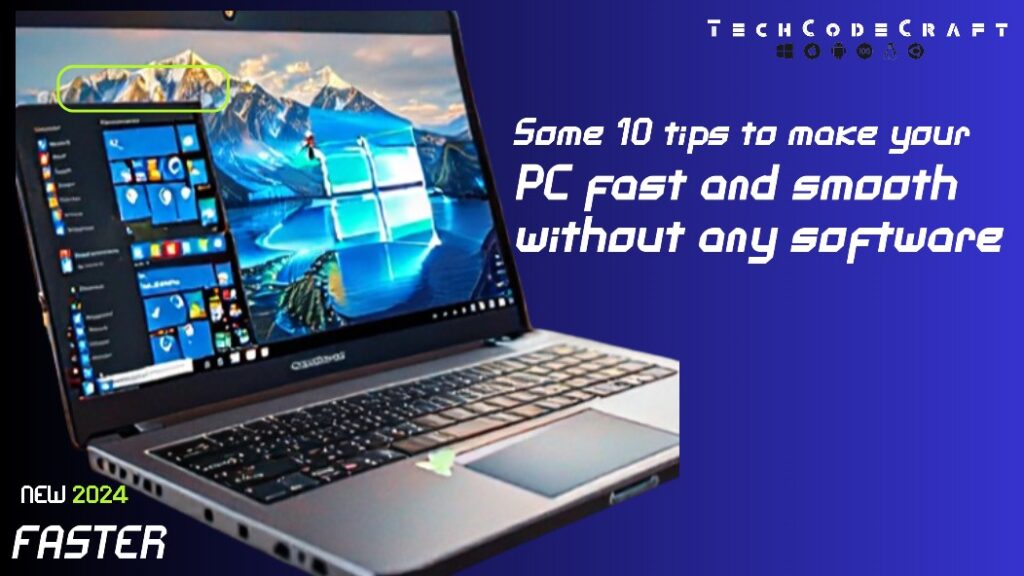Some 10 tips to make your PC fast and smooth without any software
- Productivity: A fast and smooth-running PC allows you to work more efficiently. You can launch applications quickly, switch between tasks seamlessly, and complete projects without delays caused by sluggish performance.
- User Experience: A smooth PC provides a better user experience. It reduces frustration and irritation caused by slow response times, freezes, and crashes, allowing you to enjoy using your computer without interruptions.
- Multitasking: With a fast PC, you can multitask more effectively. You can run multiple applications simultaneously, such as browsing the internet while streaming music or working on documents, without experiencing significant slowdowns.
- Performance of Resource-Intensive Tasks: Many tasks, such as video editing, gaming, and running complex software, require significant system resources. A fast PC ensures smooth performance during these resource-intensive tasks, allowing you to complete them efficiently.
- Longevity of Hardware: A well-maintained PC is less likely to experience hardware failures and overheating issues. By keeping your PC fast and smooth, you can extend the lifespan of your hardware components, reducing the need for costly repairs or replacements.
- Security: A slow PC may be more vulnerable to security threats, as outdated software and unpatched vulnerabilities can be exploited by malicious actors. Keeping your PC fast and up-to-date with the latest security patches helps protect your system from malware, viruses, and other cyber threats.
- Cost-Effectiveness: Regular maintenance and optimization of your PC can save you money in the long run. By preventing performance degradation and hardware failures, you can avoid the need for expensive upgrades or replacements.
Overall, keeping your PC fast and smooth is essential for maintaining productivity, enhancing user experience, optimizing performance, ensuring security, and prolonging the lifespan of your computer hardware. It enables you to make the most of your computing resources and enjoy a hassle-free computing experience.
Some 10 tips to make your PC fast and smooth without any software
- Reduce Startup Programs:
- Step 1: Press Ctrl + Shift + Esc to open Task Manager.
- Step 2: Go to the “Startup” tab.
- Step 3: Right-click on unnecessary programs and select “Disable”.
- Explanation: Disabling startup programs reduces the number of applications that launch automatically when you start your PC, which can improve boot time and overall performance.
- Uninstall Unused Programs:
- Step 1: Go to Control Panel > Programs > Programs and Features.
- Step 2: Select programs you no longer need and click “Uninstall”.
- Explanation: Removing unused programs frees up disk space and reduces system resource consumption, leading to improved performance.
- Clean Up Disk Space:
- Step 1: Type “Disk Cleanup” in the Windows search bar and open the tool.
- Step 2: Select the drive you want to clean up (usually C:).
- Step 3: Check the boxes for the types of files you want to delete and click “OK”.
- Explanation: Disk Cleanup removes temporary files, cache, and other unnecessary data, which can optimize disk space and improve system performance.
- Defragment Hard Drive (if using HDD):
- Step 1: Type “Defragment” in the Windows search bar and open the Defragment and Optimize Drives tool.
- Step 2: Select the drive you want to defragment and click “Optimize”.
- Explanation: Defragmenting your hard drive rearranges fragmented data, which can improve read/write speeds and overall system performance.
- Adjust Power Settings:
- Step 1: Go to Control Panel > Hardware and Sound > Power Options.
- Step 2: Select the “High Performance” power plan.
- Explanation: The High Performance power plan prioritizes performance over energy efficiency, which can improve system responsiveness.
- Update Device Drivers:
- Step 1: Right-click on the Start button and select Device Manager.
- Step 2: Expand categories and right-click on devices to update drivers.
- Step 3: Select “Search automatically for updated driver software”.
- Explanation: Updating device drivers ensures compatibility, stability, and performance improvements for hardware components.
- Scan for Malware and Viruses:
- Step 1: Install reputable antivirus software if not already installed.
- Step 2: Perform a full system scan.
- Step 3: Follow the software prompts to remove detected threats.
- Explanation: Malware and viruses can significantly degrade system performance. Regular scans help detect and remove malicious software.
- Disable Visual Effects:
- Step 1: Right-click on the Start button and select System.
- Step 2: Go to Advanced system settings.
- Step 3: Under the Performance section, click Settings.
- Step 4: Select “Adjust for best performance” or customize settings.
- Explanation: Disabling visual effects reduces system resource consumption, improving performance on older or less powerful PCs.
- Upgrade Hardware Components:
- Step 1: Identify hardware components needing upgrade (RAM, HDD to SSD, etc.).
- Step 2: Research compatible components and purchase.
- Step 3: Follow manufacturer instructions to install new hardware.
- Explanation: Upgrading hardware components can significantly enhance system performance and responsiveness.
- Regular Maintenance and Updates:
- Step 1: Enable automatic Windows updates.
- Step 2: Keep drivers, software, and antivirus definitions up to date.
- Step 3: Schedule regular system maintenance tasks (disk cleanup, defragmentation, etc.).
- Explanation: Regular maintenance and updates help ensure optimal performance and security for your PC.
By following these step-by-step tips, you can optimize your PC’s performance, making it faster and smoother for everyday use.
You May Also Like:

